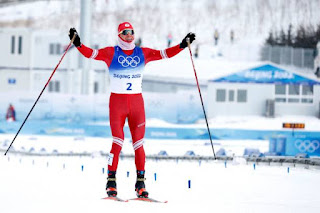And, I'm talking about the best international moments of Beijing 2.0, so you won't be seeing women's figure skating on this list. It was, without question, THE dominant story of this Olympics. The entire thing was just surreal in how it played out. But there was nothing good about it. Just the opposite. Everything about that situation was so wrong in so many ways.
Fortunately, there were plenty of good stories to emerge from Beijing 2.0 too. There was the amazing Chinese-American freestyle skier (who received so much online hate it was disgusting) and the brilliance of the five-time medalists in biathlon and cross-country skiing. There was sheer dominance by the Swiss on the alpine slopes and the Germans at the sliding center. And there were some wonderful, at-long-last golds in team sports that you couldn't help but feel good about. To name just a few.
10. The Jamaican bobsled team is back: Everyone knows Cool Runnings, the movie about the Jamaican bobsled team's debut at the 1988 Calgary Games. Their results gradually improved until 1998, which was their last Olympic appearance in the four-man event...until now. They finished last. It didn't matter. It was still great to have them back.
9. From off the team to a back-to-back gold medalist: Switzerland's alpine ski team is so deep that Michelle Gisin wasn't chosen to compete in the women's downhill despite finishing fifth at the 2021 World Championships. She did compete in the Super G and won bronze. Then, in the combined, she won her second consecutive gold medal, becoming the first repeat Olympic champion in the event.
8. Dutch treat: The Dutch long track speed skating team has been the best in the world for quite some time, but the short track team is quickly catching up. And Suzanne Schulting did something in Beijing that had never been done before--win a medal in all four women's events, gold in the 1000 and relay, silver in the 500, bronze in the 1500.
7. Breakthrough for New Zealand: Zoi Sadowski Synnott took gold in the women's slopestyle event in snowboarding, New Zealand's first-ever at the Winter Olympics. She then added a silver in the big air competition. Then, at the end of the Games, Nico Porteous, the bronze medalist in 2018, gave New Zealand its second gold in the men's freeski halfpipe.
6. History at the sliding center: Germany completely dominated the three sliding sports, winning nine of the 10 gold medals awarded in luge, skeleton and bobsled, and sweeping the four-man bobsled competition. Francesco Friedrich and Natalie Geisenberger were a big part of that history. Friedrich won gold in both two-man and four-man bobsled, becoming the first driver to sweep both events at back-to-back Olympics. Geisenberger, meanwhile, won her third straight Olympic title in women's luge and, combined with her third straight gold in the team event, is now a six-time Olympic champion.
5. Curling gold for two of the world's best: Sweden's Nicklas Edin and Great Britain's Evie Muirhead are two of the most successful curling skips in history. All they were missing was Olympic gold. Not anymore. Edin, who finished fourth in 2010, third in 2014 and second in 2018, finally won his Olympic title while Muirhead made up for the disappointment of losing the bronze medal game in PyeongChang with an absolutely dominant performance in the gold medal game in Beijing.
4. The five-timers: Three different biathletes won five medals apiece, including two men who swept every gold medal between them. Norway's Johannes Thingnes Boe won four and a bronze. France's Quentin Fillon Maillet won two and three silvers. They both almost won six medals. Fillon Maillet was fourth in the one event where he didn't medal and Boe was fifth in the one event where he didn't. On the women's side, meanwhile, Norway's Marte Olsbu Roeiseland did win a medal in all four individual events, as well as a gold in the mixed relay. And, on the cross-country side of the venue, Aleksander Bolshunov of the ROC captured three gold, a silver and a bronze, giving him an incredible nine Olympic medals in nine career Olympic races.
3. China's figure skating gold: Pairs is usually the first event in Olympic figure skating. In Beijing they put it last. Why? Because China had a chance to win gold. Sui Wenjing and Han Cong had won silver in PyeongChang, but faced stiff competition from the three pairs representing the ROC (sidebar, we all know they're Russia, this OAR and ROC thing was just stupid!). The competition was supposed to be close. And it was. But, in the end, Sui and Han's brilliant free skate gave China its figure skating gold.
1. Eileen Gu simply sensational: San Francisco-born Eileen Gu is a Stanford-bound fashion model who's a dual US and Chinese citizen who just happens to speak fluent Mandarin. She chose to represent China and figured to be one of the faces of these Games. And she sure was! Gold in the Olympic debut of big air freestyle skiing, then silver in slopestyle before capping it off with a second gold in her specialty--the halfpipe. As she said in her interview with NBC, "Eileen Gu, three-time Olympic medalist. That's just crazy!"
I'm also gonna give honorable mention to a few athletes: Swedish speed skater Nils Van Der Poel for setting a world record in the 10,000 and an Olympic record in the 5000; Dutch speed skater Irene Schouten sweeping the three women's distance events; Slovenia's Ursa Bogataj for ski jumping gold in the women's individual and mixed team events; and the brilliant French ice dancers Gabby Papadakis & Guillaume Cizeron on getting their first Olympic gold. Just a few of the many great performances we saw in Beijing.
















No comments:
Post a Comment